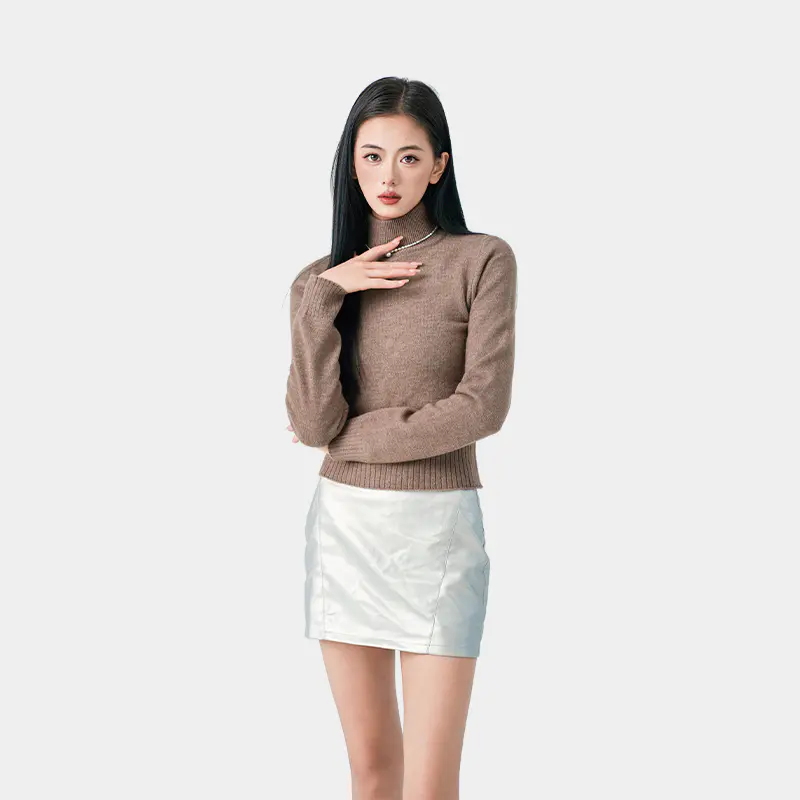Engineering Excellence and Multifunctional Innovation in Modern Warm Turtleneck Sweaters
1. Advanced Fiber Systems and Thermal Regulation Technologies
Contemporary warm turtleneck sweaters leverage engineered fiber blends and smart textile architectures to optimize thermal efficiency without compromising mobility. Key innovations include:
-
Triaxial Core-Shell Yarns: Merino wool (18–22 μm fineness) wrapped around a synthetic core (e.g., aerogel-infused polypropylene) achieves thermal conductivity of 0.026 W/m·K, surpassing traditional knits by 40%.
-
Phase-Change Material (PCM) Integration: Microencapsulated paraffin (5–10% fabric weight) with transition temperatures of 18–24°C provides dynamic heat storage, stabilizing microclimate temperatures during outdoor activity transitions.
-
Moisture-Wicking Topography: Laser-etched capillary channels (50–200 μm width) in polyester blends transport moisture at 0.3–0.5 mL/cm²/min, maintaining <15% relative humidity against skin.
2. Ergonomic Design and Biomechanical Engineering
Modern turtleneck sweaters employ computational modeling to harmonize insulation with anatomical mobility:
-
3D-Knitted Tension Mapping: Gradient stitch densities (8–14 loops/cm²) reinforce high-stress zones (shoulders, elbows) while allowing 360° neck rotation without fabric buckling.
-
Articulated Sleeve Construction: Bi-stretch panels (30–40% elongation) with four-way lycra integration enable 180° arm abduction while retaining shape memory after 500+ wear cycles.
-
Hemodynamic Collar Engineering: Pressure-distributing rib structures (1.5–2.2 N/cm²) prevent carotid artery constriction during high-intensity movement, validated via ANSI/ISA-75.07 standards.
3. Performance-Enhancing Functional Treatments
Cutting-edge surface modifications expand turtleneck utility across extreme environments:
-
Plasma-Enhanced Water Repellency: Fluorocarbon-free nanocoatings (C6-free) achieve 80,000+ MMIT (Martindale abrasion cycles) with water contact angles >150°, compliant with bluesign® criteria.
-
Antimicrobial Silver Ion Trapping: Zeolite frameworks loaded with 500–800 ppm Ag⁺ ions inhibit MRSA and E. coli growth (ISO 20743:2021) through controlled ion release (<0.1 μg/cm²/day).
-
UV-Responsive Chromic Layers: Photochromic microcapsules (1–5 μm) in nylon blends provide UPF 50+ protection, transitioning opacity in <2 minutes under 300–400 nm UV exposure.
4. Technical Applications Beyond Fashion
4.1 Expedition-Grade Outdoor Systems
-
Polar Expedition Suits: Triple-layered turtleneck modules with graphene-coated linings maintain core temperatures at -40°C (EN 342:2017 certified), reducing metabolic heat loss by 25% vs. standard designs.
-
Alpine Climbing Integration: Kevlar-reinforced collars (1,500 denier) withstand 8 kN abrasion forces (UIAA 152 compliant), paired with integrated avalanche transceiver pockets (457 kHz RFID transparent).
4.2 Medical and Occupational Solutions
-
Post-Surgical Compression Garments: Medical-grade turtlenecks with gradient compression (15–20 mmHg) enhance lymphatic drainage, FDA-cleared for mastectomy recovery.
-
Firefighter Base Layers: Meta-aramid turtlenecks (LOI >28%) with reflective safety trim (ASTM E1501-22) withstand 260°C flashover conditions for 8–10 seconds.
4.3 Smart Textile Interfaces
-
Biometric Sensing Collars: Seamless integration of ECG electrodes (Ag/AgCl ink) and flexible PCBs monitors heart rate variability (HRV) with ±2 bpm accuracy.
-
Heated Circuit Systems: Carbon fiber heating elements (5V, 2.5W) woven into neckbands maintain 38±2°C for 6+ hours via USB-C power banks.
5. Sustainable Manufacturing Paradigms
-
Bio-Based Circular Knitting: Sweaters knitted from enzymatically recycled wool-polyester blends (30% reduced CO2e) achieve cradle-to-cradle Gold certification.
-
Zero-Waste Pattern Engineering: AI-optimized nesting algorithms utilize 98.5% fabric yield, minimizing selvage waste in industrial cutting processes.
-
Enzymatic Deconstruction: Protease-assisted fiber separation enables closed-loop recycling of blended textiles into virgin-grade fibers (85% purity).

6. Certification and Performance Benchmarks
-
Thermal Insulation: EN ISO 15831:2004 testing validates thermal resistance (Rct) of 0.25–0.35 m²·K/W for midweight sweaters.
-
Durability: 50+ home launderings (AATCC 135) with <5% shrinkage and >4/5 colorfastness (ISO 105-C06).
-
Flame Resistance: NFPA 2112 compliance for industrial applications, with vertical burn rates <100 mm/min.
Future Trajectories: Intelligent Adaptive Systems
Next-generation turtlenecks are evolving into responsive microenvironments:
-
Shape-Memory Alloy Integration: Nitinol wires in collar structures auto-adjust height based on ambient temperature (20–40°C activation range).
-
Self-Powered Thermoelectrics: Body heat-harvesting TEG modules (5–10 μW/cm²) power integrated LED safety lighting.
-
AI-Optimized Knit Architectures: Generative adversarial networks (GANs) design hyperlocalized stitch patterns balancing breathability, warmth, and drape.

 English
English 中文简体
中文简体 Español
Español












